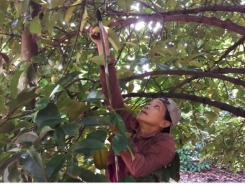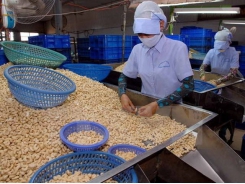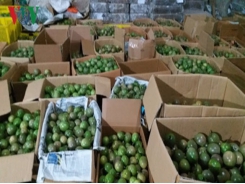US clamour for Vietnamese produce

Spurred on by the growing demand in the United States for quality Vietnamese products, domestic exporters have been working to boost their sales to one of the world’s most lucrative markets.
Thanks to renewed interest from the United States, a raft of Vietnamese products will become more readily available in the country, Photo: Le Toan
After successfully exporting three containers of mangoes to the United States, Green Path Vietnam JSC, an import and export company in Hanoi, is preparing for their next export shipments.
“The first time, we exported mangoes from the northern province of Son La. This time, we will export the same product from the south-western province of Vinh Long,” Phung Thi Thu Huong, general director of Green Path Vietnam, told VIR.
According to Huong, mangoes exported to America have to meet three requirements. “The growing areas and the packaging units must meet the standards set by the United States Department of Agriculture (USDA) and be granted a code by the US. The irradiation plant must also be certified by the US,” she said.
Huong also emphasised that there are three elements which determine the success of Vietnam’s fruits in the international market. These are the price, quality, and indigenous uniqueness of the exported goods. “We have to focus on all three elements, not just quality or price. Only by combining the three, can we have a good market share in places like the US.”
In February, after over 10 years of negotiation, Vietnamese mangoes were officially licensed to enter the US market. This is Vietnam’s sixth fresh fruit to enter this Western market, following dragon fruit, rambutan, longan, lychees, and star apples.
As one of Vietnam’s leading exporters of fresh fruits to America, Vina T&T Group exported its first batch of mangoes, a total of 20 tonnes, to the US in April. Since then, the company has continued exporting its mangoes to this market on a weekly basis.
“After one month, we successfully exported 71 tonnes of mangoes there. We are exporting about 10 tonnes per week until the crop ends,” said Nguyen Dinh Tung, general director of Vina T&T.
Tung added that in 2018, the group’s revenue from fruit exporting hit $30 million. “Mangoes will help us increase our revenue by 15 to 20 per cent in 2019,” he affirmed.
According to information released on the website of the Ministry of Agriculture and Rural Development (MARD), in 2018, exporting mangoes and products made from mangoes earned $193.2 million for Vietnam. This is an increase of 24 per cent compared to the previous year, and accounts for 5 per cent of the total turnover of fruits and vegetables in the country.
With about 46 different varieties planted in the country, mangoes can become a considerable source of income for the Vietnamese agriculture industry. At the moment, Vietnam produces over 969,000 tonnes of mangoes per year, with an estimated worth value of nearly $750 million. With their sights set on a new market, Vietnamese producers now have even more incentive to increase their production.
Positive signals
Aside from mangoes, a number of other Vietnamese agricultural products are welcome in the US.
According to data released by the General Statistics of Vietnam, in the first four months of 2019, the export value of coffee, tea, rice, fruit, vegetables, cashews, and pepper to the US reached $508 million, accounting for nearly 11 per cent of Vietnam’s total export value for the mentioned products.
Meanwhile, statistics from the MARD showed that, from January to April, the US continued to be the second-biggest consuming market of Vietnam’s coffee. The export value is estimated at $110 million, and accounts for 10.1 per cent of the market share. However, only 15 per cent of the coffee imported into the US comes from Vietnam, meaning there is still potential for coffee exporters in Vietnam to increase their market share.
According to the National Coffee Association of America (NCA), about 63 per cent of adults consume coffee daily, of which 59 per cent consume specialty coffee. Furthermore, young Americans have become more inclined to seek out specialty coffee, and the development of small, local coffee shops allows them to try coffee from all over the world.
The US is the top export destination for both Vietnamese pepper and cashews, with total export value of $53 million and $295 million, respectively.
“Vietnam’s agricultural products exported to the US show the country’s producing ability,” Thao Xuan Sung, chairman of the Vietnam Farmer’s Union, told VIR. “The US is a fastidious market, which demands the world’s highest technical standards.”
“For this reason, entering the market also means that Vietnam’s agricultural exports have obtained a “passport” to expand opportunities to other high-grade markets,” he added. “This is a foundation for countries from the EU and members of the Comprehensive and Progressive Agreement for Trans-Pacific Partnership to trust in us.”
Meanwhile, the Vietnam Trade Office in the US has been working with Rhee Bothers Group, one of the biggest chains of Asian food distribution, to get more orders for Vietnamese products.
Robert Tran, general director of RBNC, a Canadian strategic consultant company, said that despite being a market with strict import regulations, America provides enormous potential for Vietnam’s agricultural products.
“The US, with GDP of $20.5 trillion in 2018, does not need cheap products, but suitable ones with good and stable quality,” he said.
Making changes
According to Tran, to achieve results, it is important to comprehensively change the mode of production, business, and export. “It is necessary to select production areas where climate, altitude, light, humidity, soil, water sources, and other environmental factors are favourable for cultivating high quality coffee.”
Tran also emphasised the importance of using technology to create high quality products. “Manufacturers also need to pay attention to the working environment, workers’ life, community responsibility, and work to achieve certifications such as Fair Trade, and Organic,” Tran added.
In talks with VIR, Virginia Foote, chairwoman of the American Chamber of Commerce (Amcham) in Vietnam, said that many kinds of Vietnamese agricultural products can be exported to America, where they will be welcomed by consumers. However, she emphasised the importance of food safety. “Food imported in the US has to comply with the food standards and safety requirements. American consumers want to know the food is healthy, safe, and clean,” she said.
With an understanding of the incredible untapped potential that lies in the American market, Vietnam’s agricultural companies are trying to make the necessary improvements.
“We are focusing on producing the best quality products, and preserving those products for as long as possible,” said Huong of Green Path. “We use an electric monitoring procedure and an organic planting procedure from the US.”
Huong also said that the company is investing in new food processing areas, high-tech breeding areas, and activated carbon processing areas, in an attempt to produce fertiliser that will build a solid foundation for the development of organic agriculture in the country.
Meanwhile, Tung from Vina T&T said that in order to ensure that quality and size standards are met, his company has closely co-operated with farms to strictly control the planting procedures.
“All our material areas have been granted codes, and we tightly follow the VietGAP and Global GAP standards, which help us make products that answer to the calls of the US market.”
Related news
Tools

Phối trộn thức ăn chăn nuôi

Pha dung dịch thủy canh

Định mức cho tôm ăn

Phối trộn phân bón NPK

Xác định tỷ lệ tôm sống

Chuyển đổi đơn vị phân bón

Xác định công suất sục khí

Chuyển đổi đơn vị tôm

Tính diện tích nhà kính

Tính thể tích ao




 Agricultural sector maintains growth in first half
Agricultural sector maintains growth in first half  Son La boosts trade promotion activities for exports…
Son La boosts trade promotion activities for exports…